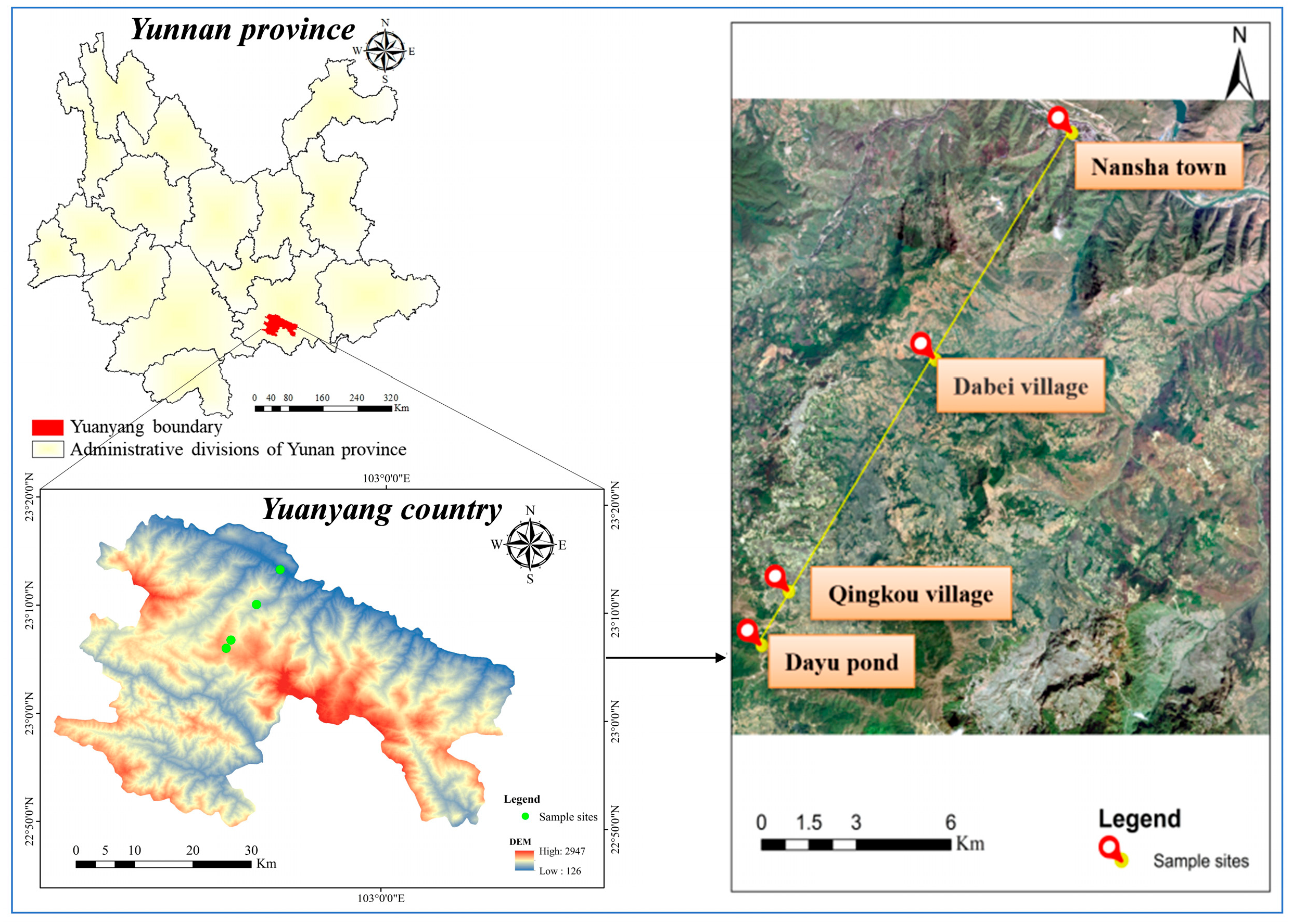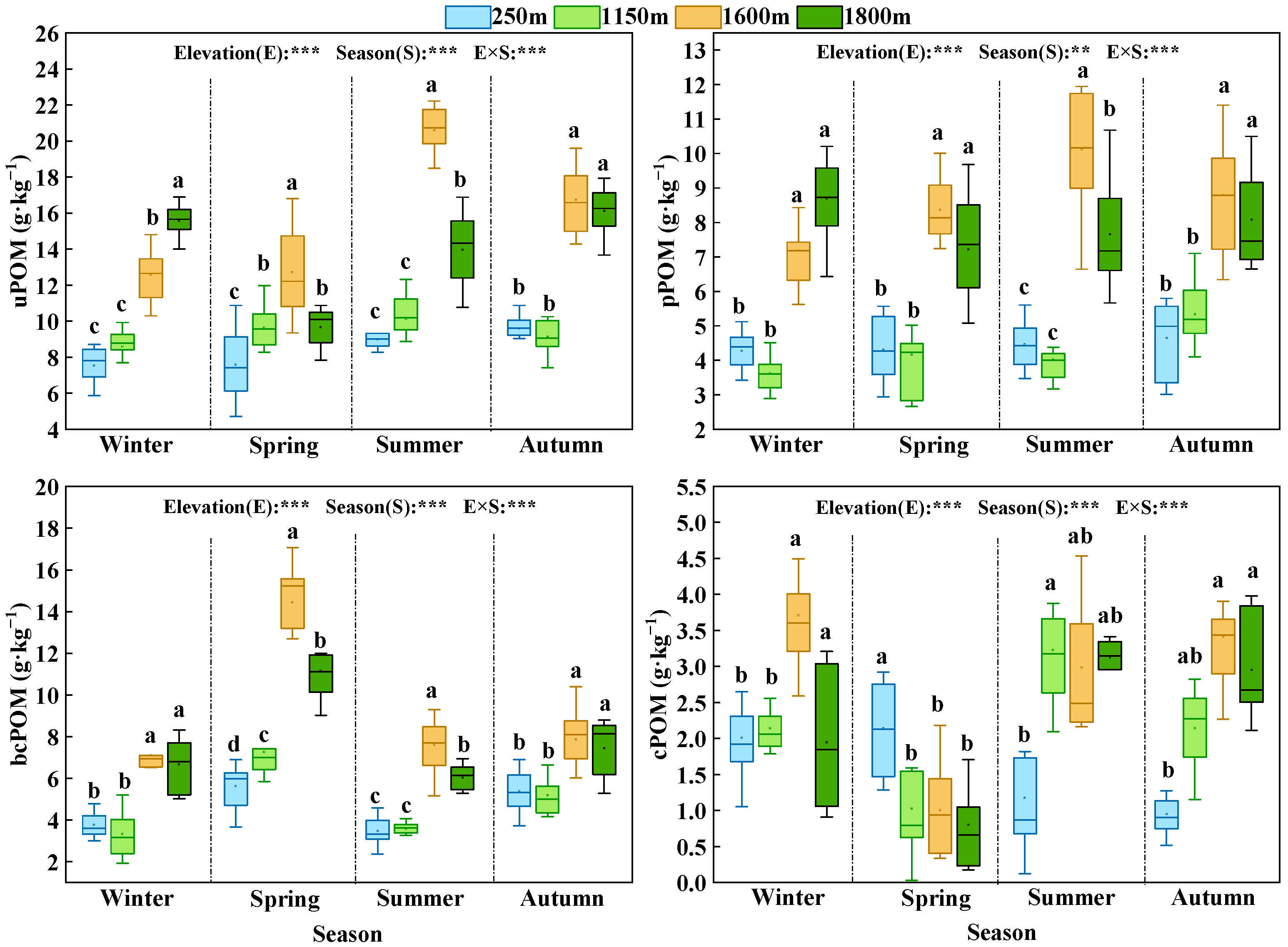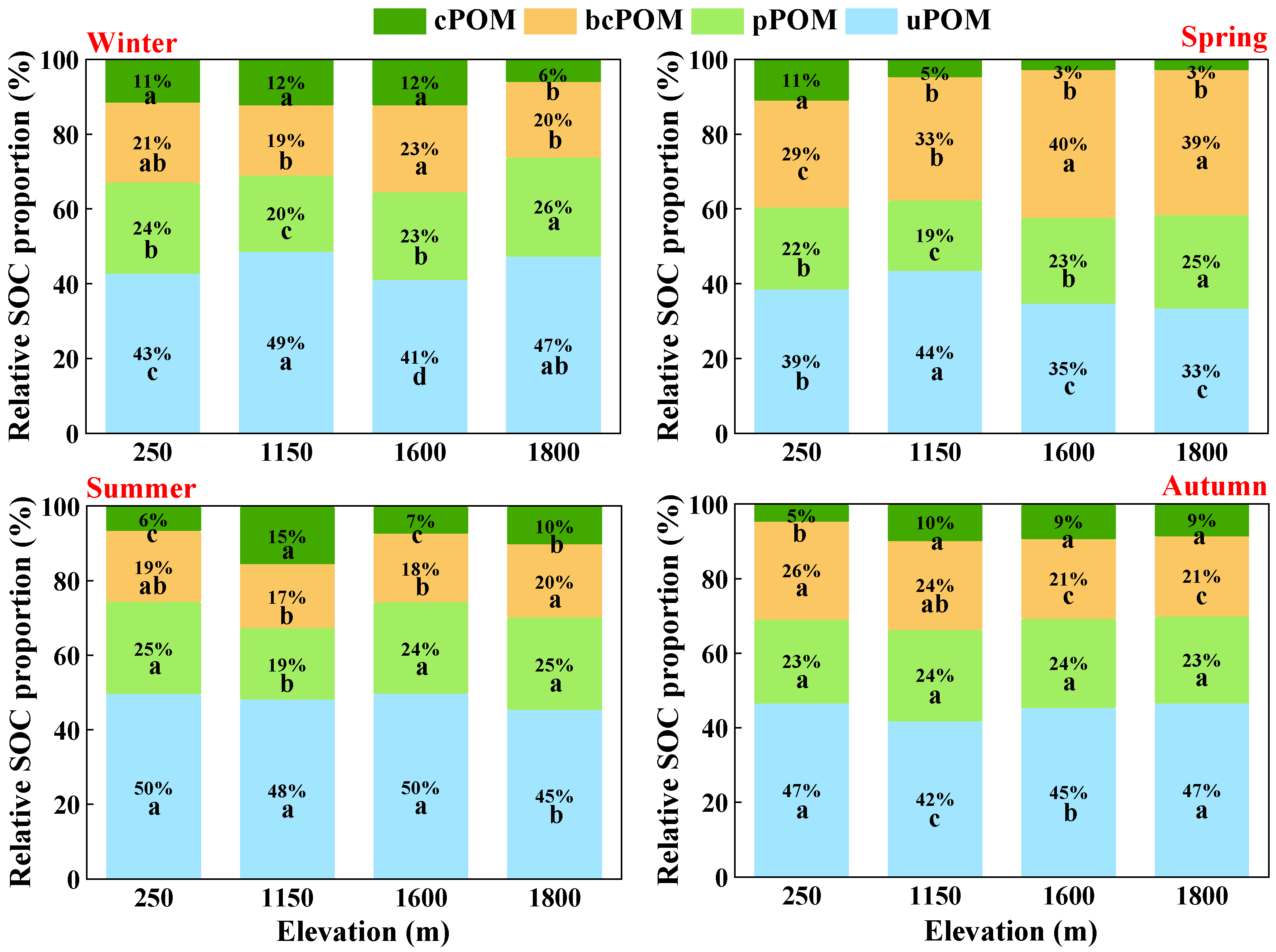Elevational Patterns and Seasonal Dynamics of Soil Organic Carbon Fractions and Content in Rice Paddies of Yuanyang Terrace, Southwest China
Abstract
1. Introduction
2. Materials and Methods
2.1. Summary of the Study Area
2.2. Soil Sample Collection
2.3. Laboratory Analysis
2.3.1. Determination of Soil Physical and Chemical Properties
2.3.2. Soil OC Grouping and Determination
2.4. Data Processing and Statistical Analysis
3. Results
3.1. Analysis of Soil Environmental Factors
3.2. SOC and SOC Fraction Contents in Rice Paddies
3.3. Proportion of SOC Fractions to SOC in Rice Paddies
3.4. Correlation Analysis
4. Discussion
4.1. Soil OC Fractions in Rice Paddy
4.2. Soil OC Fractions and Stability Changes in Rice Paddies Along the Elevation Gradient
4.3. Correlation Between SOC Fractions in Rice Paddies and Soil Environmental Factors
5. Conclusions
Author Contributions
Funding
Data Availability Statement
Acknowledgments
Conflicts of Interest
References
- Kikstra, J.S.; Nicholls, Z.R.J.; Smith, C.J.; Lewis, J.; Lamboll, R.D.; Byers, E.; Riahi, K. The IPCC Sixth Assessment Report WGIII climate assessment of mitigation pathways: From emissions to global temperatures. Geosci. Model Dev. 2022, 15, 9075–9109. [Google Scholar] [CrossRef]
- Francisco, E.; Pierre, P.; Carlos, G.G.; Benjamín, M.L. A time-series analysis of the 20th century climate simulations produced for the IPCC’s Fourth Assessment Report. PLoS ONE 2013, 8, e60017. [Google Scholar]
- Scharlemann, J.P.W.; Tanner, E.V.J.; Hiederer, R.; Kapos, V. Global soil carbon: Understanding and managing the largest terrestrial carbon pool. Carbon Manag. 2014, 5, 81–91. [Google Scholar] [CrossRef]
- Mark, A. Climate Change 2014: Synthesis Report; IPCC: Geneva, Switzerland, 2016; Volume 141, p. 28. [Google Scholar]
- Luo, Z.K.; Feng, W.T.; Luo, Y.Q.; Baldock, J.; Wang, E.L. Soil organic carbon dynamics jointly controlled by climate, carbon inputs, soil properties and soil carbon fractions. Glob. Change Biol. 2017, 23, 4430–4439. [Google Scholar] [CrossRef]
- Liang, C.; Schimel, J.P.; Jastrow, J.D. The importance of anabolism in microbial control over soil carbon storage. Nat. Microbiol. 2017, 2, 17105. [Google Scholar] [CrossRef]
- Lützow, M.V.; Kögel-Knabner, I.; Ekschmitt, K.; Flessa, H.; Guggenberger, G.; Matzner, E.; Marschner, B. SOM fractionation methods: Relevance to functional pools and to stabilization mechanisms. Soil Biol. Biochem. 2007, 39, 2183–2207. [Google Scholar] [CrossRef]
- Six, J.; Conant, R.T.; Paul, E.A.; Paustian, K. Stabilization mechanisms of soil organic matter: Implications for C-saturation of soils. Plant Soil 2002, 241, 155–176. [Google Scholar] [CrossRef]
- Stewart, C.E.; Plante, A.F.; Paustian, K.; Conant, R.T.; Six, J. Soil carbon saturation: Linking concept and measurable carbon pools. Soil Sci. Soc. Am. J. 2008, 72, 379–392. [Google Scholar] [CrossRef]
- Stewart, C.E.; Paustian, K.; Conant, R.T.; Plante, A.F.; Six, J. Soil carbon saturation: Implications for measurable carbon pool dynamics in long-term incubations. Soil Biol. Biochem. 2009, 41, 357–366. [Google Scholar] [CrossRef]
- Wang, B.; Hao, S.; Zhang, Q.L. Protection mechanisms and influencing factors of soil organic carbon pools in the Larix gmelinii forests. Ecol. Indic. 2023, 150, 110242. [Google Scholar] [CrossRef]
- Feng, J.; Xu, X.; Wu, J.J.; Zhang, Q.; Zhang, D.D.; Li, Q.X.; Long, C.Y.; Chen, Q.; Chen, J.W.; Cheng, X.L. Inhibited enzyme activities in soil macroaggregates contribute to enhanced soil carbon sequestration under afforestation in central China. Sci. Total Environ. 2018, 640–641, 653–661. [Google Scholar] [CrossRef]
- Thevenot, M.; Dignac, M.F.; Rumpel, C. Fate of lignins in soils: A review. Soil Biol. Biochem. 2010, 42, 1200–1211. [Google Scholar] [CrossRef]
- Zinn, Y.L.; Andrade, A.B.; Araujo, M.A.; Lal, R. Soil organic carbon retention more affected by altitude than texture in a forested mountain range in Brazil. Soil Res. 2018, 56, 284–295. [Google Scholar] [CrossRef]
- Tian, Q.X.; Jiang, Y.; Tang, Y.N.; Wu, Y.; Tang, Z.Y.; Liu, F. Soil pH and organic carbon properties drive soil bacterial communities in surface and deep layers along an elevational gradient. Front. Microbiol. 2021, 12, 646124. [Google Scholar] [CrossRef]
- Wiesmeier, M.; Urbanski, L.; Hobley, E.; Lang, B.; Lützow, M.V.; Steffens, M.; Wesemael, B.V.; Rabot, E.; Ließ, M.; Garcia-Franco, N.; et al. Soil organic carbon storage as a key function of soils—A review of drivers and indicators at various scales. Geoderma 2019, 333, 149–162. [Google Scholar] [CrossRef]
- Wu, M.Y.; Pang, D.B.; Chen, L.; Li, X.B.; Liu, L.Z.; Liu, B.; Li, J.Y.; Wang, J.F.; Ma, L.L. Chemical composition of soil organic carbon and aggregate stability along an elevation gradient in Helan Mountains, northwest China. Ecol. Indic. 2021, 131, 108228. [Google Scholar] [CrossRef]
- Li, L.G.; Vogel, J.; He, Z.L.; Zou, X.M.; Ruan, H.H.; Huang, W.; Wang, J.S.; Bianchi, T.S. Association of soil aggregation with the distribution and quality of organic carbon in soil along an elevation gradient on Wuyi Mountain in China. PLoS ONE 2016, 11, e0150898. [Google Scholar] [CrossRef]
- Schiedung, H.; Bornemann, L.; Welp, G. Seasonal variability of soil organic carbon fractions under arable land. Pedosphere 2017, 27, 380–386. [Google Scholar] [CrossRef]
- Sun, X.L.; Tang, Z.X.; Ryan, M.G.; You, Y.M.; Sun, O.J. Changes in soil organic carbon contents and fractionations of forests along a climatic gradient in China. For. Ecosyst. 2019, 6, 1. [Google Scholar] [CrossRef]
- Wang, Y.; Zhang, C.; Song, W.F.; He, X.; Zhang, S.D. Spatial distribution characteristic of Yuanyang Rice Terrace. Res. Soil Water Conserv. 2013, 20, 103–107. [Google Scholar]
- Sundqvist, M.K.; Sanders, N.J.; Wardle, D.A. Community and ecosystem responses to elevational gradients: Processes, mechanisms, and insights for global change. Annu. Rev. Ecol. Evol. Syst. 2013, 44, 261–280. [Google Scholar] [CrossRef]
- Liu, Z.L.; Ding, Y.P.; Jiao, H.M.; Liu, C.J. Identification of potential abandoned farmland and driving factors in Honghe Hani Rice Terrace. Chin. J. Eco-Agric. 2020, 28, 124–135. [Google Scholar]
- Zhang, X.J.; Song, W.F.; Wu, J.K.; Wang, Z.J. Characteristics of hydrogen and oxygen isotopes of soil water in the water source area of Yuanyang Terrace. Environ. Sci. 2015, 36, 2102–2108. [Google Scholar]
- Bao, S.D. Soil Agrochemical Analysis, 3rd ed.; China Agricultural Press: Beijing, China, 2000. [Google Scholar]
- Li, W.J.; Huang, Q.H.; Li, D.M.; Liu, K.L.; Zhang, W.J.; Xu, M.G. Variation characteristics of organic carbon pools with different protection methods in upland red soil under long-term fertilization. J. Agric. Resour. Environ. 2023, 40, 106–115. [Google Scholar]
- Zhang, R.; Zhang, G.; Ji, Y.; Li, G.; Chang, H.; Yang, D. Effects of different fertilizer application on soil active organic carbon. Environ. Sci. 2013, 34, 277–282. [Google Scholar]
- Somasundaram, J.; Chaudhary, R.S.; Awanish, K.D.; Biswas, A.K.; Sinha, N.K.; Mohanty, M.; Hati, K.M.; Jha, P.; Sankar, M.; Patra, A.K.; et al. Effect of contrasting tillage and cropping systems on soil aggregation, carbon pools and aggregate-associated carbon in rainfed Vertisols. Eur. J. Soil Sci. 2018, 69, 879–891. [Google Scholar] [CrossRef]
- Xu, M.; Xiao, L.; Cai, X.; Li, X.; Zhang, X.; Zhang, J. Impact of land use type on soil organic carbon fractionation and turnover in Southeastern Tibet. Sci. Agric. Sin. 2018, 51, 3714–3725. [Google Scholar]
- Zhang, X.T.; Wang, J.; Feng, X.Y.; Yang, H.S.; Li, Y.L.; Kuzyakov, Y.; Liu, S.P.; Li, F.M. Effects of tillage on soil organic carbon and crop yield under straw return. Agric. Ecosyst. Environ. 2023, 354, 108543. [Google Scholar] [CrossRef]
- Six, J.; Paustian, K. Aggregate-associated soil organic matter as an ecosystem property and a measurement tool. Soil Biol. Biochem. 2014, 68, A4–A9. [Google Scholar] [CrossRef]
- Xu, M.G.; Li, R.; Sun, N.; An, Y.Q.; Wang, X.L.; Jin, D.S.; Li, J.H.; Zhang, Q.; Hong, J.P.; Shen, H.P. Soil organic carbon sequestration efficiency and fractions as affected by organic fertilization rate in reclaimed cultivated land. J. Plant Nutr. Fertil. 2022, 28, 2143–2151. [Google Scholar]
- Xu, X.R.; Zhang, W.J.; Xu, M.G.; Li, S.Y.; An, T.T.; Pei, J.B.; Xiao, J.; Xie, H.T.; Wang, J.K. Characteristics of differently stabilised soil organic carbon fractions in relation to long-term fertilisation in brown earth of Northeast China. Sci. Total Environ. 2016, 572, 1101–1110. [Google Scholar] [CrossRef] [PubMed]
- Wu, M.Y.; Chen, L.; Ma, J.P.; Zhang, Y.; Li, X.B.; Pang, D.B. Aggregate-associated carbon contributes to soil organic carbon accumulation along the elevation gradient of Helan Mountains. Soil Biol. Biochem. 2023, 178, 108926. [Google Scholar] [CrossRef]
- França, E.M.; Silva, C.A.; Zinn, Y.L. Coffee plantations can strongly sequester soil organic carbon at high altitudes in Brazil. Soil Res. 2022, 61, 198–207. [Google Scholar] [CrossRef]
- Feyissa, A.; Raza, S.T.; Cheng, X.L. Soil carbon stabilization and potential stabilizing mechanisms along elevational gradients in alpine forest and grassland ecosystems of Southwest China. Catena 2023, 229, 107210. [Google Scholar] [CrossRef]
- Pu, Y.L.; Ye, C.; Zhang, S.R.; Wang, G.Y.; Hu, S.J.; Xu, X.X.; Xiang, S.; Li, T.; Jia, Y.X. Response of the organic carbon fractions and stability of soil to alpine marsh degradation in Zoige, East Qinghai-Tibet Plateau. J. Soil Sci. Plant Nutr. 2020, 20, 2145–2155. [Google Scholar] [CrossRef]
- Kong, J.; He, Z.; Chen, L.; Yang, R.; Du, J.; Lin, P.; Zhu, X.; Tian, Q. Elevational gradients and distributions of aggregate associated organic carbon and nitrogen and stability in alpine forest ecosystems. Soil Sci. Soc. Am. J. 2020, 84, 1971–1982. [Google Scholar] [CrossRef]
- Tashi, S.; Singh, B.; Keitel, C.; Adams, M. Soil carbon and nitrogen stocks in forests along an altitudinal gradient in the eastern Himalayas and a meta-analysis of global data. Glob. Change Biol. 2016, 22, 2255–2268. [Google Scholar] [CrossRef]
- Liu, B.; Chen, L.; Pang, D.B.; Zhu, Z.Y.; Liu, L.Z.; Wu, M.Y.; Li, X.B. Altitudinal distribution rule of Larix principis-rupprechtii forest’s soil organic carbon and its influencing factors in Liupan Mountain. Acta Ecol. Sin. 2021, 41, 6773–6785. [Google Scholar]
- Li, J.S.; Wu, B.Y.; Zhang, D.D.; Cheng, X.L. Elevational variation in soil phosphorus pools and controlling factors in alpine areas of Southwest China. Geoderma 2023, 431, 116361. [Google Scholar] [CrossRef]
- Deng, L.; Peng, C.H.; Zhu, G.Y.; Chen, L.; Liu, Y.L.; Shangguan, Z.P. Positive responses of belowground C dynamics to nitrogen enrichment in China. Sci. Total Environ. 2018, 616–617, 1035–1044. [Google Scholar] [CrossRef]
- Larsen, K.S.; Andresen, L.C.; Beier, C.; Jonasson, S.; Albert, K.R.; Ambus, P.; Arndal, M.F.; Carter, M.S.; Christensen, S.; Holmstrup, M.; et al. Reduced N cycling in response to elevated CO2, warming, and drought in a Danish heathland: Synthesizing results of the climate project after two years of treatment. Glob. Change Biol. 2011, 17, 1884–1899. [Google Scholar] [CrossRef]
- Wang, W.Q.; Wang, C.; Sardans, J.; Tong, C.; Jia, R.X.; Zeng, C.S.; Peñuelas, J. Flood regime affects soil stoichiometry and the distribution of the invasive plants in subtropical estuarine wetlands in China. Catena 2015, 128, 144–154. [Google Scholar] [CrossRef]
- Liu, F.D.; Liu, Y.H.; Wang, G.M.; Song, Y.; Liu, Q.; Li, D.S. Seasonal variations of C:N:P stoichiometry and their trade-offs in different organs of Suaeda salsa in coastal wetland of Yellow River Delta, China. PLoS ONE 2015, 10, e0138169. [Google Scholar]
- Zhang, W.L.; Zeng, C.S.; Tong, C.; Zhai, S.J.; Lin, X.; Gao, D.Z. Spatial distribution of phosphorus speciation in marsh sediments along a hydrologic gradient in a subtropical estuarine wetland, China. Estuar. Coast. Shelf Sci. 2015, 154, 30–38. [Google Scholar] [CrossRef]
- Hartmann, A.A.; Barnard, R.L.; Marhan, S.; Niklaus, P.A. Effects of drought and N-fertilization on N cycling in two grassland soils. Oecologia 2013, 171, 705–717. [Google Scholar] [CrossRef]
- Kuzyakov, Y.; Horwath, W.R.; Dorodnikov, M.; Blagodatskaya, E. Review and synthesis of the effects of elevated atmospheric CO2 on soil processes: No changes in pools, but increased fluxes and accelerated cycles. Soil Biol. Biochem. 2019, 128, 66–78. [Google Scholar] [CrossRef]
- Kuzyakov, Y.; Xu, X. Competition between roots and microorganisms for nitrogen: Mechanisms and ecological relevance. New Phytol. 2013, 198, 656–669. [Google Scholar] [CrossRef]
- Du, B.M.; Kang, H.Z.; Pumpanen, J.; Zhu, P.H.; Yin, S.; Zou, Q.; Wang, Z.; Kong, P.Q.; Liu, C.J. Soil organic carbon stock and chemical composition along an altitude gradient in the Lushan Mountain, subtropical China. Ecol. Res. 2014, 29, 433–439. [Google Scholar] [CrossRef]
- Qi, R.; Li, J.; Lin, Z.A.; Li, Z.J.; Li, Y.T.; Yang, X.D.; Zhang, J.J.; Zhao, B.Q. Temperature effects on soil organic carbon, soil labile organic carbon fractions, and soil enzyme activities under long-term fertilization regimes. Appl. Soil Ecol. 2016, 102, 36–45. [Google Scholar] [CrossRef]
- Mi, W.H.; Sun, Y.; Zhao, C.; Wu, L.G. Soil organic carbon and its labile fractions in paddy soil as influenced by water regimes and straw management. Agric. Water Manag. 2019, 224, 105752. [Google Scholar] [CrossRef]
- Qian, J.; Liu, J.J.; Wang, P.F.; Wang, C.; Li, K.; Shen, M.M. Riparian soil physicochemical properties and correlation with soil organic carbon of an inflowing river of Taihu Lake. IOP Conf. Ser. Earth Environ. Sci. 2017, 59, 012053. [Google Scholar] [CrossRef]
- Ma, H.P.; Yang, X.L.; Guo, Q.Q.; Zhang, X.J.; Zhou, C.N. Soil organic carbon pool along different altitudinal level in the Sygera Mountains, Tibetan Plateau. J. Mt. Sci. 2016, 13, 476–483. [Google Scholar] [CrossRef]
- Martinez, G.; Vanderlinden, K.; Ordóez, R.; Muriel, J.L. Can apparent electrical conductivity improve the spatial characterization of soil organic carbon? Vadose Zone J. 2009, 8, 586–593. [Google Scholar] [CrossRef]
- Gaudel, G.; Mosongo, P.S.; Xing, L.; Oljira, A.M.; Zhang, Y.M.; Bizimana, F.; Liu, B.; Wang, Y.Y.; Dong, W.X.; Hu, C.S.; et al. Meta-analysis of the priming effect on native soil organic carbon in response to glucose amendment across soil depth. Plant Soil 2022, 479, 107–124. [Google Scholar] [CrossRef]








| Index | Molecular Freedom | Denominator Freedom | F Value | p Value |
|---|---|---|---|---|
| SOC | 3 | 156 | 105.156 | <0.0001 |
| uPOM | 3 | 156 | 104.779 | <0.0001 |
| bPOM | 3 | 156 | 115.012 | <0.0001 |
| bcPOM | 3 | 156 | 73.548 | <0.0001 |
| cPOM | 3 | 156 | 33.604 | <0.001 |
Disclaimer/Publisher’s Note: The statements, opinions and data contained in all publications are solely those of the individual author(s) and contributor(s) and not of MDPI and/or the editor(s). MDPI and/or the editor(s) disclaim responsibility for any injury to people or property resulting from any ideas, methods, instructions or products referred to in the content. |
© 2025 by the authors. Licensee MDPI, Basel, Switzerland. This article is an open access article distributed under the terms and conditions of the Creative Commons Attribution (CC BY) license (https://creativecommons.org/licenses/by/4.0/).
Share and Cite
Li, H.; Chang, L.; Wu, Y.; Li, Y.; Liang, X.; Zhan, F.; He, Y. Elevational Patterns and Seasonal Dynamics of Soil Organic Carbon Fractions and Content in Rice Paddies of Yuanyang Terrace, Southwest China. Agronomy 2025, 15, 1868. https://doi.org/10.3390/agronomy15081868
Li H, Chang L, Wu Y, Li Y, Liang X, Zhan F, He Y. Elevational Patterns and Seasonal Dynamics of Soil Organic Carbon Fractions and Content in Rice Paddies of Yuanyang Terrace, Southwest China. Agronomy. 2025; 15(8):1868. https://doi.org/10.3390/agronomy15081868
Chicago/Turabian StyleLi, Haitao, Linxi Chang, Yonglin Wu, Yang Li, Xinran Liang, Fangdong Zhan, and Yongmei He. 2025. "Elevational Patterns and Seasonal Dynamics of Soil Organic Carbon Fractions and Content in Rice Paddies of Yuanyang Terrace, Southwest China" Agronomy 15, no. 8: 1868. https://doi.org/10.3390/agronomy15081868
APA StyleLi, H., Chang, L., Wu, Y., Li, Y., Liang, X., Zhan, F., & He, Y. (2025). Elevational Patterns and Seasonal Dynamics of Soil Organic Carbon Fractions and Content in Rice Paddies of Yuanyang Terrace, Southwest China. Agronomy, 15(8), 1868. https://doi.org/10.3390/agronomy15081868





